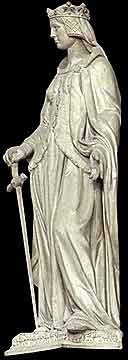Margaret of Anjou (1430-1482)
© 2007
Armchair Travel Co. Ltd. - This page may be used for non-commercial purposes
ONLY!
![]()

[ Play
Narrated and Animated Movie ! ] The world is always disposed to consider what is done by a great and powerful monarch as of course right, and even when it would seem to them wrong they believe that its having that appearance is only because the are not in a position to form a just judgement on the question, not being fully acquainted with the facts.
Although of high birth, Margaret's family had fallen on hard times and she was brought up in genteel poverty. She was small and stout with a pear-shaped face and her marriage settlement with Henry VI included a two-year truce between England and France. Soon after her arrival in England at the age of 15 she caught smallpox and to provide her with suitable clothes for the wedding, as her own were pitifully shabby, her new husband had to pawn the crown jewels. An inauspicious start, and her marriage aroused much antipathy not only among the populace who had had enough of French queens, but also amongst the rival Lancastrian, of which her father as a descendant of John of Gaunt was one, and Yorkist, led by Richard, Duke of York, factions.
In 1453, Margaret had a son, Edward, her only child, and her husband had the first of many fits of madness. These events forced Richard's hand, as he had hoped to succeed Henry in the normal course of events, and so after realising this was no longer possible he prepared for war. After Henry had been captured and forced to disinherit Edward, Margaret rallied her forces and defeated the Yorkists at Wakefield, killing Richard. Her reputation was not improved by her forces pillaging the countryside after the battle or by her forcing her seven-year-old son to condemn all prisoners to death after the second battle of St. Albans.
After losing to the Yorkists at Towton Margaret and her son fled to Scotland and thence to France when, in 1461, Edward of York (son of Richard) was crowned king. They lived there for eight years without support from Louis XI until the Earl of Warwick turned on Edward and captured him. But after unwisely releasing him, Warwick had to flee to France where Louis reconciled him with Margaret and helped him to raise an army. Warwick then returned to England, causing Edward to flee for his life and placed Henry on the throne again. Margaret then left for England with her son, but after Warwick had been killed at Barnet she was also defeated with her army at Tewkesbury - her son killed and she captured and put in the Tower. Henry VI had been murdered in the Tower shortly before.
For another four years she languished in prison until, ransomed by her father, she returned to France. An unsympathetic Louis XI ensured she remained in poverty until her death in 1482.
I, Margaret, formerly in England married, renounce all that I could pretend to in England by the conditions of my marriage, will all other things there to Edward, now king of England...
[ Virtual
Tour ] [ Main Topics
Index ]
- Remark to Henry VI, her husband. Quoted in The History of Marguerite d'Anjou, 1861.
Additional Information on
Margaret of Anjou (1430-1482)
QUOTATION
- A document Margaret was forced to sign, before being allowed to return to France on the deaths of her husband and son.
Explore-Parliament.net: Advanced Category Search
Keyword Categories:
_Object_Sculpture
_Object_Artwork
_Object_Portrait
_Artist_Thames_Bank_Workshop
_Queen
_Royal_Family
_Woman
_Person
_Consort
_Margaret_of_Anjou